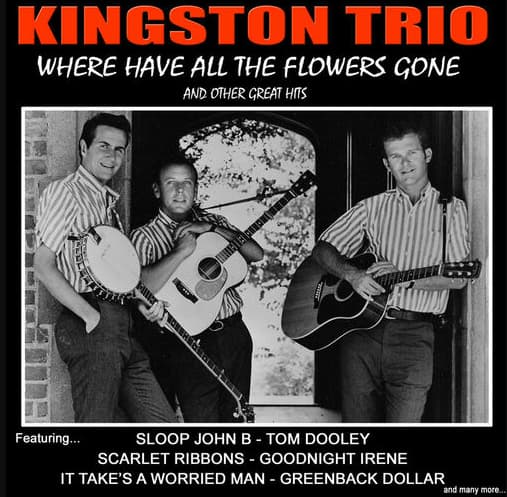
The Kingston Trio – “Where Have All the Flowers Gone?”: A Timeless Anthem of Reflection and Loss
The Kingston Trio’s rendition of “Where Have All the Flowers Gone?” is a poignant and reflective folk song that grapples with themes of war, peace, and the cyclical nature of human conflict. Written by Pete Seeger in 1955 and later adapted with additional verses by Joe Hickerson, the song became a standard of the folk revival movement. The Kingston Trio’s 1961 version brought the song widespread attention, reaching No. 21 on the Billboard Hot 100 and No. 4 on the Easy Listening chart, solidifying its place as a timeless classic.
The song opens with a gentle guitar strum and the Trio’s signature harmonies, creating a sense of simplicity and introspection. The arrangement is minimalist, with acoustic instrumentation that allows the lyrics and melody to take center stage. This stripped-down approach emphasizes the song’s folk roots and its message of universal longing for peace and understanding.
Lyrically, “Where Have All the Flowers Gone?” is structured as a series of rhetorical questions that reflect on the tragic consequences of war. Each verse builds upon the previous one, tracing a symbolic cycle: flowers are picked by young girls, who marry young men, who go to war, leaving behind graves that eventually sprout flowers again. The repetition of the question “Where have all the flowers gone?” underscores the futility and sorrow of this endless loop, making the song both meditative and haunting.
The chorus, “When will they ever learn? Oh, when will they ever learn?” is a plea for humanity to break free from the destructive patterns of history. This refrain, repeated at the end of each verse, resonates deeply with listeners, serving as both a lament and a call to action. Its simplicity and universality have made it a powerful anthem for peace movements around the world.
The Kingston Trio’s vocal harmonies are a defining feature of their version, blending seamlessly to create a rich, emotional sound. Their delivery is restrained yet deeply expressive, capturing the somber tone of the lyrics while maintaining a sense of hope and introspection. The group’s ability to convey such profound emotion with subtlety makes their rendition particularly impactful.
The musical arrangement is understated but effective, with acoustic guitars providing a steady rhythm and a soft, melodic foundation. The gentle strumming mirrors the cyclical nature of the lyrics, reinforcing the theme of repetition and continuity. This simplicity allows the listener to focus on the message of the song, ensuring its emotional weight is fully realized.
Since its release, “Where Have All the Flowers Gone?” has become one of the most enduring songs of the 20th century, embraced by peace activists and folk enthusiasts alike. Its themes of loss, reflection, and the desire for change have remained relevant across generations, ensuring its place in the canon of protest songs. The Kingston Trio’s version, with its polished harmonies and accessible style, helped introduce the song to a mainstream audience, making it a cultural touchstone of the early 1960s.
The song’s legacy extends far beyond its initial success. It has been covered by a wide range of artists, including Joan Baez, Peter, Paul and Mary, and Marlene Dietrich, each adding their own interpretation while preserving its core message. Its use in anti-war protests, civil rights demonstrations, and educational settings has solidified its status as a timeless anthem of social conscience.
In the end, “Where Have All the Flowers Gone?” is more than just a folk song—it’s a meditation on the human condition and a call for introspection and change. The Kingston Trio’s heartfelt rendition, combined with the song’s universal themes and elegant simplicity, creates a piece that continues to inspire and resonate with listeners. For fans of folk music and those who believe in the power of music to effect change, “Where Have All the Flowers Gone?” remains a powerful and enduring reminder of the cost of conflict and the hope for peace.